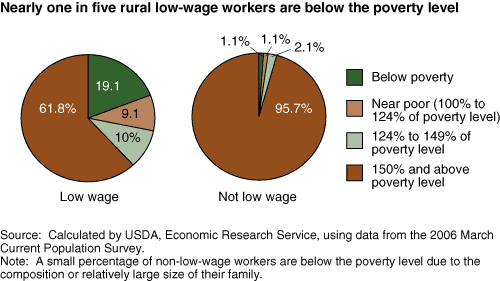Rural Low-Wage Workers Face Multiple Economic Disadvantages
- by Robert Gibbs and Timothy Park
- 6/1/2007
Nearly one in four wage and salary workers age 25 and older living in rural (nonmetro) America in 2005 were low- wage workers. Low-wage workers in 2005 are defined as workers earning less on a full-time, full-year basis than the weighted four-person poverty threshold ($19,971). The financial difficulties that these low-wage workers face are often compounded by limited job-related benefits, such as employer-based health insurance, and lower overall family income. Among all rural workers, low-wage workers are therefore more likely to participate in Federal assistance programs as a means to ensure a measure of economic security.
Families typically pool economic resources, so the earnings of a single member may not be indicative of the worker’s or the family’s well-being. The income available to the average rural low-wage worker from sources other than their own earnings, however, is lower than for other rural workers. Median family income for rural low-wage workers in 2005 was $28,000, about 53 percent less than the median ($59,200) for other rural wage and salary workers. Rural low-wage workers are also less likely to be in two-earner households (55 percent compared with 69 percent). Their more limited access to additional income largely explains a poverty rate of 19.1 percent among rural low-wage workers, compared with 1.1 percent for other rural workers. A small percentage of non-low-wage workers are below the poverty level due to the composition or relatively large size of their family. Another 9.1 percent are considered near poor, with incomes between 100 and 124 percent of the poverty level.
In addition to lower family income, rural low-wage workers are often concentrated in economic sectors with a greater share of seasonal and part-time jobs, such as agriculture, retail trade, and other services. These jobs, in turn, are associated with greater earnings instability and lower nonmonetary benefits. Rural low-wage workers, for example, are only half as likely to be covered by an employer-sponsored health plan as other rural workers (33 percent compared with 68 percent). However, more than a third are engaged in industries such as manufacturing, education, and health services, which have an above-average record of providing employer-sponsored health insurance.
Rural low-wage workers are more likely than other rural workers to seek assistance from government programs such as food stamps and school lunch programs. Although only 1.6 percent of rural low-wage workers received public assistance (welfare payments), 15.2 percent of their households received food stamps or school lunch subsidies (versus 2.6 percent for other rural workers). Also, 57.3 percent of children in rural households with a low-wage worker received free or reduced-price school lunches, compared with 19.7 percent of children in other rural households.
This article is drawn from:
- Employment & Education - Rural Education. (n.d.). U.S. Department of Agriculture, Economic Research Service.
You may also like:
- County-level Data Sets. (n.d.). U.S. Department of Agriculture, Economic Research Service.


